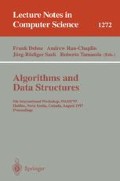Abstract
This paper addresses the problem of planning the motion of one or more pursuers in a polygonal environment to eventually “see” an evader that is unpredictable, has unknown initial position, and is capable of moving arbitrarily fast. This problem was first introduced by Suzuki and Yamashita. Our study of this problem is motivated in part by robotics applications, such as surveillance with a mobile robot equipped with a camera that must find a moving target in a cluttered workspace. A few bounds are introduced, and a complete algorithm is presented for computing a successful motion strategy for a single pursuer. For simply-connected free spaces, it is shown that the minimum number of pursuers required is θ(lg n). For multiply-connected free spaces, the bound is θ(√h+lg n) pursuers for a polygon that has n edges and h holes. A set of problems that are solvable by a single pursuer and require a linear number of recontaminations is shown. The complete algorithm searches a finite cell complex that is constructed on the basis of critical information changes. It has been implemented and computed examples are shown.
Preview
Unable to display preview. Download preview PDF.
References
T. Ba§ar and G. J. Olsder. Dynamic Noncooperative Game Theory. Academic Press, London, 1982.
D. Bienstock and P. Seymour, Monotonicity in graph searching. J. Algorithms, 12:239–245, 1991.
B. Chazelle. A theorem on polygon cutting with applications. In Proc. 23rd Annu. IEEE Sympos. Found. Comput. Sci., pages 339–349, 1982.
W.-P. Chin and S. Ntafos. Optimum watchman routes. Information Processing Letters, 28:39–44, 1988.
D. Crass, I. Suzuki, and M. Yamashita. Searching for a mobile intruder in a corridor — the open edge variant of the polygon search problem. Int. J. Comput. Geom. & Appl., 5(4):397–412, 1995.
M. Erdmann. Randomization for robot tasks: Using dynamic programming in the space of knowledge states. Algorithmica, 10:248–291, 1993.
L. Guibas and J. Stolfe. Primitives for the manipulation of general subdivisions and the computation of Voronoi diagrams. AMC Trans. Graphics, 4(2):74–123, 1985.
L. J. Guibas, R. Motwani, and P. Raghavan. The robot localization problem. In K. Goldberg, D. Halperin, J.-C. Latombe, and R. Wilson, editors, Proc. 1st Workshop on Algorithmic Foundations of Robotics, pages 269–282. A.K. Peters, Wellesley, MA, 1995.
O. Hájek. Pursuit Games. Academic Press, New York, 1975.
R. Isaacs. Differential Games. Wiley, New York, NY, 1965.
A. S. Lapaugh. Recontamination does not help to search a graph. J. ACM, 40(2):224–245, April 1993.
S. M. LaValle. A Game-Theoretic Framework for Robot Motion Planning. PhD thesis, University of Illinois, Urbana, IL, July 1995.
S. M. LaValle, D. Lin, L. J. Guibas, J.-C. Latombe, and R. Motwani. Finding an unpredictable target in a workspace with obstacles. In Prof. IEEE Int'l Conf, on Robotics and Automation, 1997.
R. J. Lipton and R. E. Tarjan. A separator theorem for planar graphs. SIAM Journal of Applied Mathematics, 36:177–189, 1979.
F. Makedon and I. H. Sudborough. Minimizing width in linear layouts. In Proc. 10th ICALP, Lecture Notes in Computer Science 154, pages 478–490. Springer-Verlag, 1983.
N. Megiddo, S. L. Hakimi, M. R. Garey, D. S. Johnson, and C. H. Papadimitriou. The complexity of searching a graph. J. ACM, 35(1):18–44, January 1988.
B. Monien and I. H. Sudborough. Min cut is NP-complete for edge weighted graphs. Theoretical Computer Science, 58:209–229, 1988.
J. O'Rourke. Art Gallery Theorems and Algorithms. Oxford University Press, New York, NY, 1987.
T. D. Parsons. Pursuit-evasion in a graph. In Y. Alani and D. R. Lick, editors, Theory and Application of Graphs, pages 426–441. Springer-Verlag, Berlin, 1976.
J. T. Schwartz and M. Sharir. On the piano movers' problem: III. Coordinating the motion of several independent bodies. Int. J. Robot. Res., 2(3):97–140, 1983.
T. Shermer. Recent results in art galleries. Proc. IEEE, 80(9):1384–1399, September 1992.
I. Suzuki and M. Yamashita. Searching for a mobile intruder in a polygonal region. SIAM J. Comput., 21(5):863–888, October 1992.
R. Talluri and J. K. Aggarwal. Mobile robot self-location using model-image feature correspondence. IEEE Trans. Robot. & Autom., 12(1):63–77, February 1996.
Author information
Authors and Affiliations
Editor information
Rights and permissions
Copyright information
© 1997 Springer-Verlag Berlin Heidelberg
About this paper
Cite this paper
Guibas, L.J., Latombe, JC., Lavalle, S.M., Lin, D., Motwani, R. (1997). Visibility-based pursuit-evasion in a polygonal environment. In: Dehne, F., Rau-Chaplin, A., Sack, JR., Tamassia, R. (eds) Algorithms and Data Structures. WADS 1997. Lecture Notes in Computer Science, vol 1272. Springer, Berlin, Heidelberg. https://doi.org/10.1007/3-540-63307-3_45
Download citation
DOI: https://doi.org/10.1007/3-540-63307-3_45
Published:
Publisher Name: Springer, Berlin, Heidelberg
Print ISBN: 978-3-540-63307-5
Online ISBN: 978-3-540-69422-9
eBook Packages: Springer Book Archive

